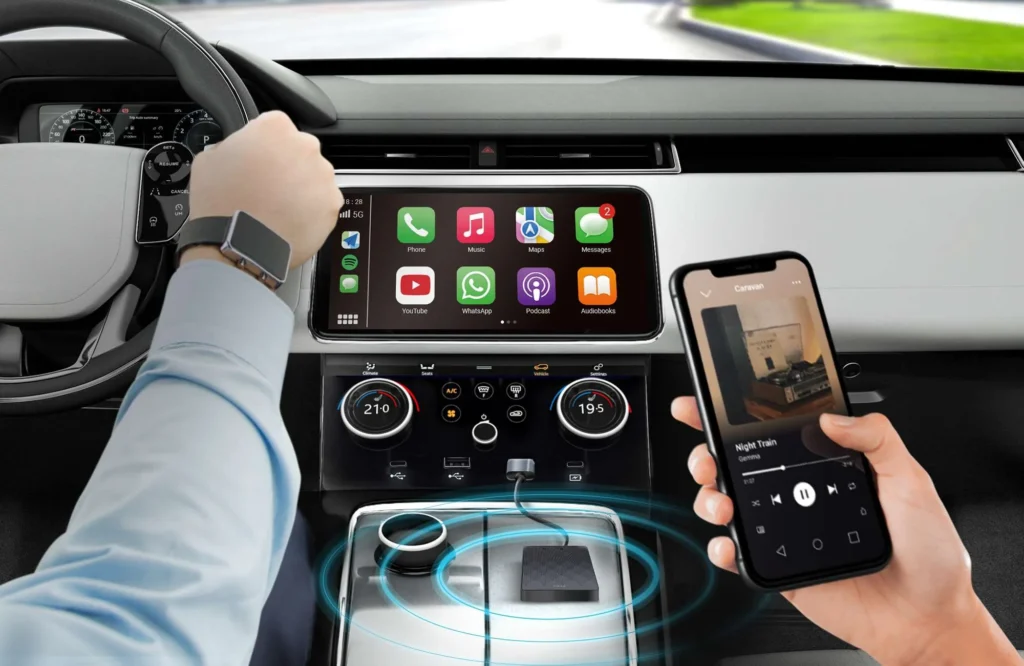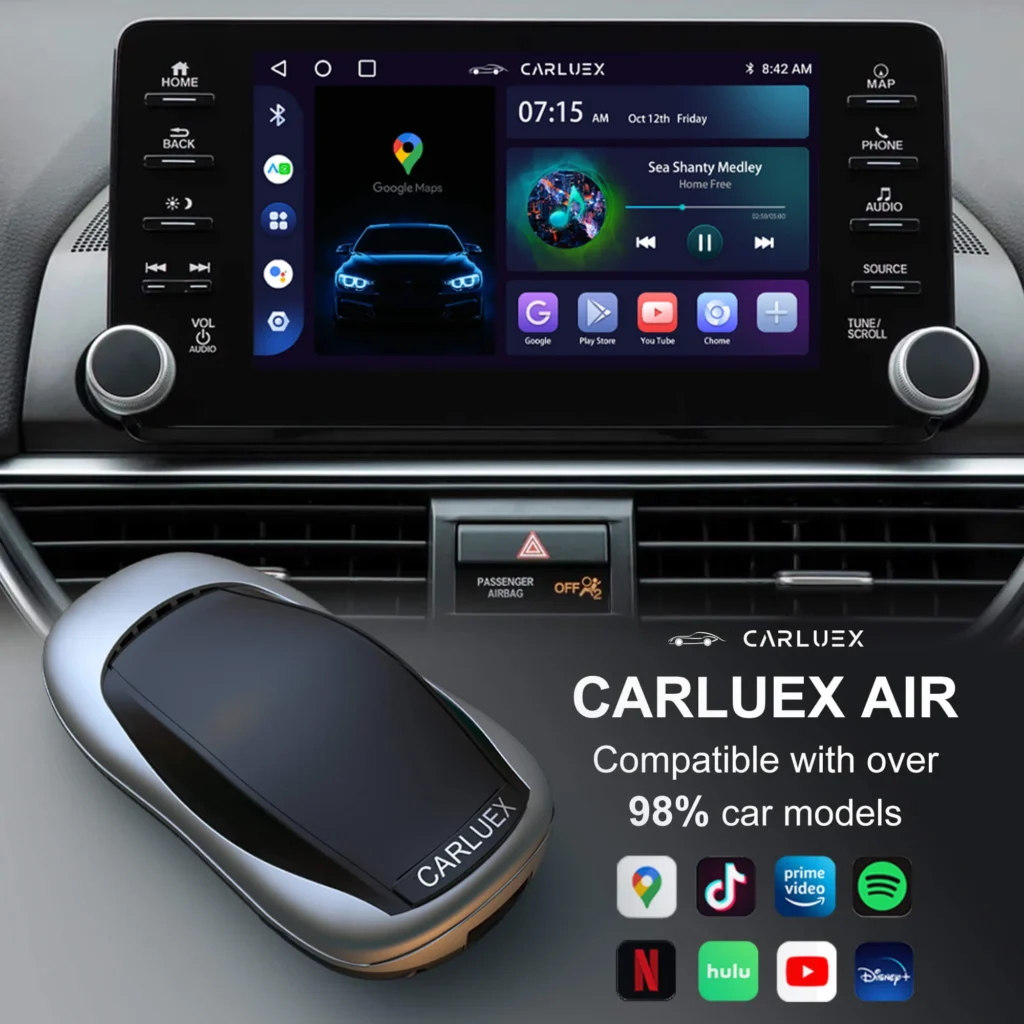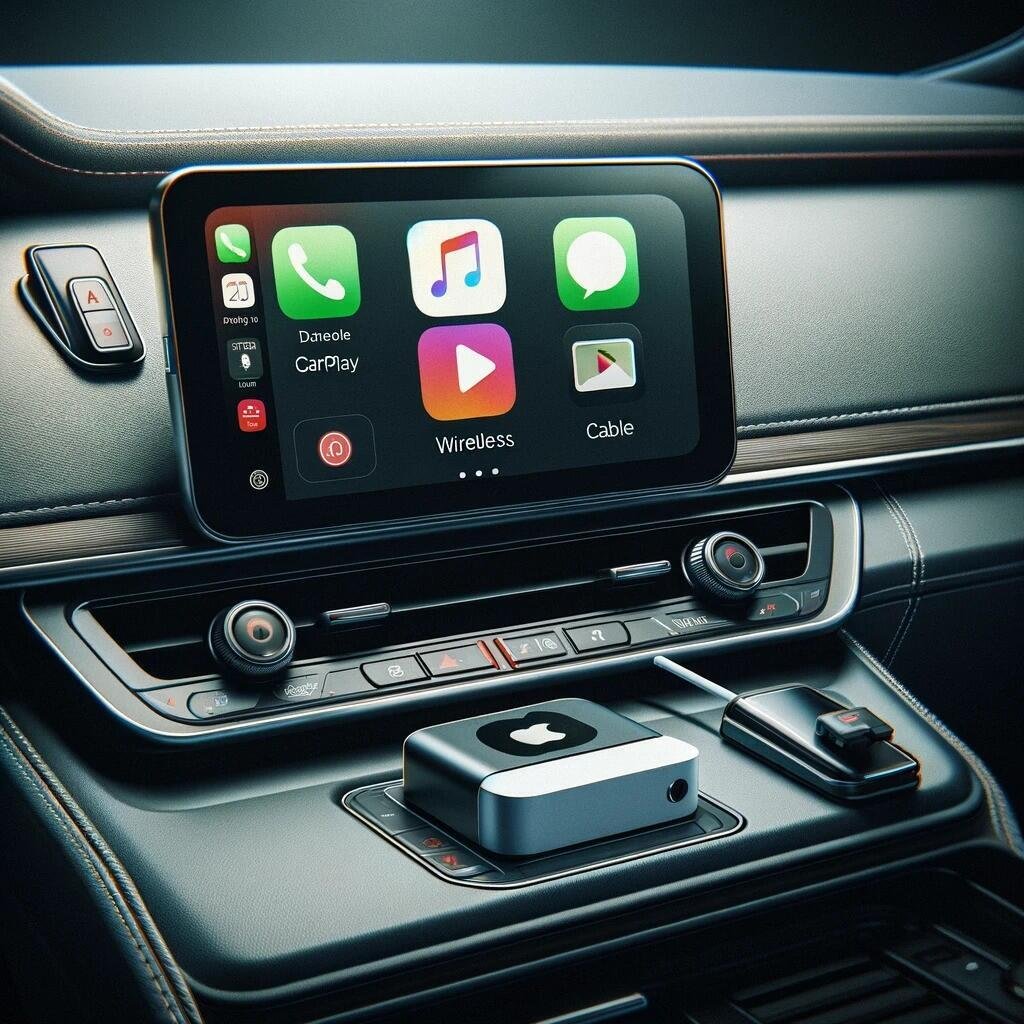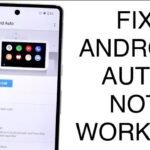Table of Contents

Imagine driving your car while seamlessly accessing your iPhone’s apps, navigation, and music without the hassle of tangled wires. This is the magic of Wireless CarPlay adapters. These nifty devices allow you to connect your iPhone to your car’s infotainment system wirelessly, providing a more convenient and clutter-free driving experience. In this blog, we’ll explore how Wireless CarPlay adapters work and why they’re a game-changer for Apple users.
What is Wireless CarPlay?

Before diving into how the adapters work, it’s essential to understand what Wireless CarPlay is. CarPlay is Apple’s interface for vehicles, enabling you to use iPhone features directly through your car’s dashboard screen. While traditional CarPlay requires a wired connection via a USB cable, Wireless CarPlay allows you to connect your iPhone without any cables.
How Wireless CarPlay Adapters Work
Wireless CarPlay adapters bridge the gap between your car’s existing infotainment system and your iPhone, enabling a wireless connection. Here’s a breakdown of how they function:
- Connection to the Car’s USB Port
- The adapter is plugged into your car’s existing USB port, which would typically be used for wired CarPlay. This connection is crucial because it powers the adapter and acts as a conduit for data transmission.
- Creating a Wireless Network
- Once connected, the adapter creates a private Wi-Fi network or uses Bluetooth to establish a connection with your iPhone. The exact method can vary depending on the adapter model. Most modern adapters use a combination of Bluetooth for initial pairing and Wi-Fi for data transfer, ensuring a stable and fast connection.
- Pairing with the iPhone
- On your iPhone, you need to connect to the adapter’s Wi-Fi network and pair via Bluetooth, if required. This process is generally straightforward, similar to connecting to a Bluetooth speaker or other wireless devices. Once paired, your iPhone will automatically connect to the adapter whenever you’re in the car, eliminating the need for repeated setups.
- Transmitting Data
- The adapter wirelessly transmits data between your iPhone and the car’s infotainment system. This includes audio for music and calls, data for navigation, and other CarPlay-compatible apps. The adapter essentially mirrors your iPhone’s display onto the car’s screen, allowing you to interact with your apps using the car’s controls, such as touchscreens, knobs, or steering wheel buttons.
- Maintaining a Stable Connection
- The best adapters are designed to maintain a stable connection even in areas with poor Wi-Fi or Bluetooth signals. They often come with built-in antennas and advanced software to ensure a smooth experience, minimizing interruptions while you drive.
Benefits of Using a Wireless CarPlay Adapter
- Convenience: No need to fumble with cables every time you enter or exit your car.
- Clutter-Free: Keeps your car’s interior neat and organized.
- Quick Setup: Once paired, your iPhone automatically connects whenever you start your car.
- Enhanced Safety: Allows for safer hands-free operation of your iPhone’s features while driving.
Choosing the Right Wireless CarPlay Adapter
When choosing a Wireless CarPlay adapter, consider the following factors:
- Compatibility: Ensure the adapter is compatible with your car’s make and model and supports your iPhone’s iOS version.
- Ease of Use: Look for an adapter with a straightforward setup process and reliable performance.
- Quality and Brand Reputation: Opt for reputable brands known for quality products and good customer support.
- Firmware Updates: Some adapters offer firmware updates to improve performance and add new features.
Check the Latest Price on Amazon and Buy Now!

Additional Important Points About Wireless CarPlay Adapters
Latency and Audio Quality
One of the primary concerns with wireless connections is latency or delay, especially for audio playback and navigation prompts. While most high-quality Wireless CarPlay adapters are optimized to minimize latency, it’s worth noting that there might still be a slight delay compared to a wired connection. However, this delay is typically negligible and doesn’t significantly affect the user experience.
Power Consumption
Using Wireless CarPlay consumes more power compared to a wired connection since the iPhone’s battery isn’t being charged while in use. It’s a good practice to monitor your iPhone’s battery level and have a charging option available if you plan on using Wireless CarPlay for extended periods.
Firmware and Software Updates
Manufacturers of Wireless CarPlay adapters frequently release firmware updates to improve performance, fix bugs, and introduce new features. It’s crucial to keep your adapter’s firmware up to date. Some adapters allow for over-the-air (OTA) updates, making it easy to install updates without connecting the adapter to a computer.
Security Considerations
When using a Wireless CarPlay adapter, security is a key consideration. These adapters typically create a private Wi-Fi network for communication between the iPhone and the car’s system. Ensure that the network is secure and that you’re aware of any potential vulnerabilities. Choose adapters from reputable brands that prioritize user security and regularly release security patches.
Customizability and Additional Features
Some Wireless CarPlay adapters come with additional features and customization options, such as:
- Custom Launchers: Allows you to customize the CarPlay interface with different themes or layouts.
- Screen Mirroring: Some adapters support screen mirroring, enabling you to display your entire iPhone screen on the car’s display.
- Multiple User Profiles: Useful for cars shared among family members, allowing each user to have a personalized setup.
Range and Interference
The range of the wireless connection is another factor to consider. While the typical range should cover the entire car cabin, signal strength may vary. Interference from other electronic devices or poor car insulation can occasionally impact the connection quality. It’s advisable to test the adapter in different environments and positions within the car to find the optimal setup.
Backup Plan
It’s always wise to have a backup plan, especially if you’re relying on navigation. Keep a USB cable handy in case the wireless connection fails or the adapter encounters an issue. This ensures you can still use CarPlay via a wired connection, maintaining access to essential functions.
Compatibility with Future iOS Updates
Ensure that the Wireless CarPlay adapter you choose is compatible with future iOS updates. Some adapters may not work correctly with new iOS versions if they are not updated in time. Look for manufacturers who have a track record of timely firmware updates to ensure ongoing compatibility.
Voice Command Accuracy
The quality of voice command recognition may vary between wired and wireless setups. Wireless connections can sometimes introduce slight delays, which might affect the responsiveness of Siri or other voice assistants. Testing the adapter’s performance in recognizing voice commands can help ensure a smooth hands-free experience.
Multiple Device Connections
If you frequently switch between multiple iPhones or share the car with others, check if the adapter supports easy switching between different devices. Some adapters may allow multiple iPhones to be paired simultaneously, making it easier to switch between users without re-pairing each time.
Physical Design and Installation
Consider the physical design of the adapter, especially if your car has limited space around the USB port. Some adapters are compact and can be easily hidden, while others might require more space. Additionally, ensure that the adapter’s installation process is straightforward and doesn’t interfere with other car functions.
By considering these additional points, you can make an informed decision when selecting a Wireless CarPlay adapter that best suits your needs and preferences. This investment can significantly enhance your in-car experience, offering convenience, safety, and a touch of modern technology to your daily drives.
Conclusion
Wireless CarPlay adapters are a fantastic addition to any car that supports wired CarPlay, offering a more convenient and seamless way to use your iPhone on the road. By understanding how these adapters work and what to look for when purchasing one, you can make an informed decision and enhance your driving experience. Whether you’re navigating, streaming music, or using Siri, Wireless CarPlay makes it all easier and safer, helping you stay focused on the road.
With this knowledge, you’re ready to embrace the future of in-car connectivity. Say goodbye to tangled cables and hello to a seamless, wireless experience with Wireless CarPlay adapters!



